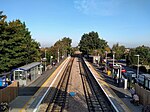Stonehouse (Bristol Road) railway station
1844 establishments in England1965 disestablishments in EnglandBeeching closures in EnglandDisused railway stations in GloucestershireFormer Midland Railway stations ... and 5 more
Pages with no open date in Infobox stationRailway stations in Great Britain closed in 1965Railway stations in Great Britain opened in 1844Stroud DistrictUse British English from March 2015

Stonehouse (Bristol Road) railway station, also known as Stroudwater station after the nearby canal, was a station in Stonehouse, England, on the Bristol and Gloucester Railway between Haresfield and Frocester.
Excerpt from the Wikipedia article Stonehouse (Bristol Road) railway station (License: CC BY-SA 3.0, Authors, Images).Stonehouse (Bristol Road) railway station
MST14,
Geographical coordinates (GPS) Address External links Nearby Places Show on map
Geographical coordinates (GPS)
| Latitude | Longitude |
|---|---|
| N 51.747 ° | E -2.2932 ° |
Address
Stonehouse Bristol Road
MST14
GL10 3RB
England, United Kingdom
Open on Google Maps









